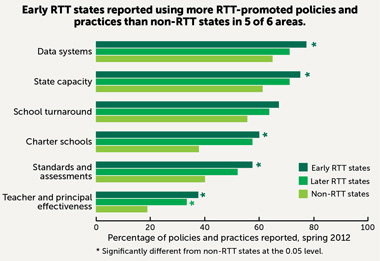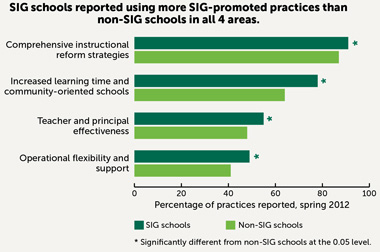States and schools that received more than $7 billion dollars in federal funding from Race to the Top (RTT) and School Improvement Grants (SIG) generally reported using more of the policies and practices promoted by these programs than those that did not receive such grants, according to a new report released by the U.S. Department of Education’s Institute of Education Sciences. The RTT and SIG programs used a variety of strategies to improve student outcomes and turn around our nation’s low-performing schools.
So far, evidence on how states and schools are implementing the RTT and SIG programs has been limited,” says Lisa Dragoset, a senior researcher at Mathematica and director of the evaluation. “This study tapped state and school administrators to shed light on these programs and lay the groundwork for a future report that will examine whether these programs helped increase student achievement.”

Through structured telephone interviews in spring 2012 with administrators in 49 states and the District of Columbia, the RTT analysis found:
- Early RTT states (which received Round 1 or Round 2 grants in 2010) reported using more RTT-promoted policies and practices than non-RTT states (which did not receive grants) in five of six areas: (1) building state data systems that measure student growth and inform instruction, (2) improving state capacity to support school improvement efforts, (3) encouraging conditions in which charter schools can succeed, (4) adopting standards and assessments that prepare students to succeed in college and the workplace, and (5) improving teacher and principal effectiveness. There were no differences between the two groups in the sixth area: turning around low-performing schools.
- Later RTT states (which received Round 3 grants in 2011) reported using more RTT-promoted policies and practices than non-RTT states in one of the six areas: teacher and principal effectiveness.
- Across all states, use of RTT-promoted policies and practices was highest in the state capacity and data systems areas and lowest in the teacher and principal effectiveness area.
- Across the six areas, there were no differences between RTT and non-RTT states in use of RTT-promoted policies and practices that focused on English language learners (ELLs).

Through surveys of school administrators at 470 schools (290 SIG schools and 180 non-SIG schools) in spring 2012, the SIG analysis found:
- SIG schools (which implemented a SIG-funded intervention model) reported using more SIG-promoted practices than non-SIG schools (which did not implement a SIG-funded intervention model) in all four areas examined: (1) comprehensive instructional reform strategies, (2) learning time and community-oriented schools, (3) teacher and principal effectiveness, and (4) operational flexibility and support.
- Across all schools, use of SIG-promoted practices was highest in the comprehensive instructional reform strategies area and lowest in the operational flexibility and support area.
- Across the four areas, there were no differences between SIG and non-SIG schools in use of SIG-promoted practices that focused on ELLs.
Cheryl Graczewski, a senior researcher at the American Institutes for Research (AIR) and one of the report’s authors, noted: “For practitioners and policymakers, this report not only identifies areas that states and schools have addressed, but also highlights areas where additional attention may be needed.”
The research is part of a large-scale, multi-year evaluation conducted by Mathematica Policy Research, AIR, and Social Policy Research Associates (SPR) for the U.S. Department of Education, Institute of Education Sciences.
About Mathematica: Mathematica Policy Research seeks to improve public well-being by conducting studies and assisting clients with program evaluation and policy research, survey design and data collection, research assessment and interpretation, and program performance/data analytics and management. Its clients include foundations, federal and state governments, and private-sector and international organizations. The employee-owned company is headquartered in Princeton, NJ, with offices in Ann Arbor, MI; Cambridge, MA; Chicago, IL; Oakland, CA; and Washington, DC.
About AIR: Established in 1946, with headquarters in Washington, D.C., the American Institutes for Research (AIR) is a nonpartisan, not-for-profit organization that conducts behavioral and social science research and delivers technical assistance both domestically and internationally in the areas of health, education, and workforce productivity. For more information, visit www.air.org.
About SPR: Social Policy Research Associates (SPR) provides customized services in evaluation, organizational development, and facilitation and training. Located in Oakland, CA, SPR works collaboratively with clients to bring innovative approaches to new or existing strategies, programs, and initiatives. The staff consists of more than 30 professionals with backgrounds in diverse disciplines, including education, sociology, public policy, and economics. For more information, visit www.spra.com.

